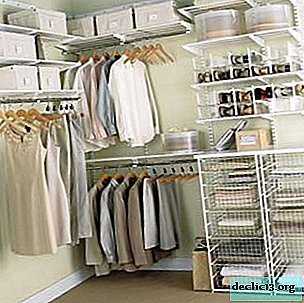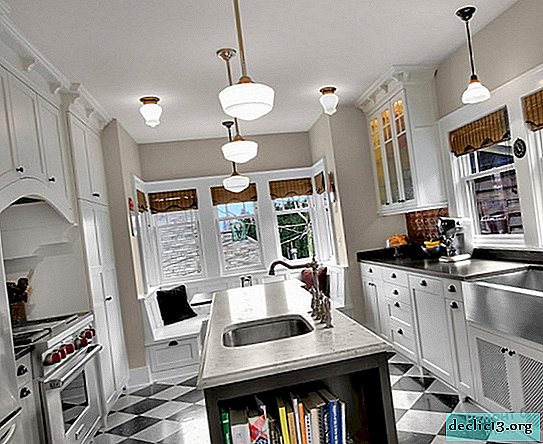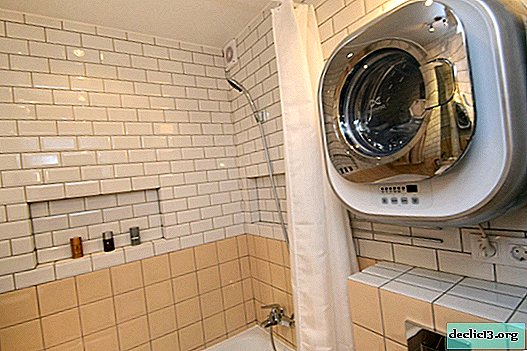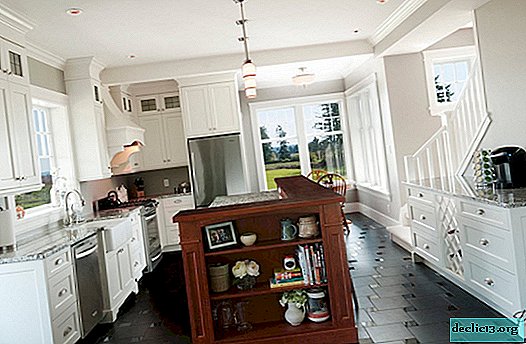How to choose accessories for the dressing room, expert advice
Choosing or creating your own dressing room, you need to think about its working mechanisms and auxiliary parts in advance. Previously, you should find out what accessories for the dressing room are, and how to choose it correctly.
Kinds
Conventionally, accessories for wardrobe systems can be divided into types depending on the functions they perform:
- if the choice falls on the swing doors or the door of the book, then the main retaining element will be the hinges. They are installed on the front of the cabinet or on the elements of its filling. There are many types of loops, the main of which are universal loops, countersunk or double-sided;
- door handles - mainly in wardrobe rooms, regardless of the design of their facade, ordinary cabinet handles that do not have moving mechanisms are used. But since this element gives access to the premises, it can be attributed to the category of working parts;
- door closers provide quiet, safe closing of swing doors. In case of refusal from closers, the installation of locking door handles is mandatory, otherwise the doors may open by themselves. There is a magnetic system for restraining doors in a closed state, but it is rarely used;
- in the case of installing compartment doors, it is worth paying attention to the choice of roller systems, which are fully responsible for the progress of the facade parts and access to the dressing room. There are both floor-mounted and mounted load-bearing systems. The quality of this mechanism depends on the rollers and on the guides;
- internal filling, regardless of its type, is attached to the base using supports, clamps, holders, supports, profiles, brackets and other details. These elements are stationary, however, they play the role of holding and fastening elements. Such parts fasten the modules together, hold the rods, hold the shelves and hangers.
Systems such as mesh have virtually no hardware. It, for example, is completely made of metal, which means that all its parts are attached directly to each other.





Additional items
Additional accessories for wardrobes are guide rails for drawers, elevator parts (pantographs), pull-out hangers and shoe racks. All these parts have quite complex designs, consisting of many parts, however, significantly simplify the life of the owners of wardrobe rooms:
- the so-called elevators, or pantographs, are designed to deliver clothes placed on the bar almost to the ceiling. It is suitable for tall compartments for outerwear. A U-shaped vertical structure is simply pulled down to a person with a cable or strap, and then returned to its original position with shock absorbers;
- in relation to drawers rotary mechanisms can be used. Especially often they are used in the construction of shoe shelves;
- for sliding shelves roller guides are also used;
- for hanging clothes and accessories in the dressing room, rods and folding hangers for ties or belts are used;
- if a chest of drawers or a table is installed in the large dressing room in the middle, then it can be made mobile with the help of wheels.
Any elements that improve the functionality, help to save the useful space of housing. This will be useful if the designer prefers compact wardrobes.
 Pantographs
Pantographs Drawer guides
Drawer guides Drawers
Drawers Shoe rack
Shoe rackMaterials of manufacture
To assemble a high-quality storage system and its subsequent operation, accessories for the dressing room should be made of quality materials. About what materials are used in the manufacture of working parts of the storage for clothes, we will describe further:
- aluminum is a high-quality, but expensive material from which both wardrobe filling elements and their details are made. Aluminum is used in the manufacture of guides, rollers, bushings, plugs, brackets, or shelf holders. Aluminum mechanisms are quiet, as well as convenient to operate;
- steel is one of the most common materials in the manufacture of dressing room elements or their moving parts. The range of mechanisms and spare parts made of steel will satisfy even the most demanding installer or designer. In addition, steel is a cheap material. From it make guides, rotary mechanisms, rollers, shock-absorbing systems, handles or locks;
- plastic is used for the manufacture of rollers in sliding systems, as well as to create plugs, guides, shock absorbers, door handles;
- the composition of zinc, aluminum and copper is called CAM. This is a common material that replaces the more expensive brass. Such details look solid and fit into almost any design. Handles, latches, stops and locks are made of this alloy;
- silumin is a cheap non-universal material. Acceptable quality can be considered fixed parts. If silumin is used in working mechanisms, then you should not load it heavily - this is a very fragile material.
 Zinc alloy
Zinc alloy Steel
Steel Silumin
Silumin Plastic
Plastic Aluminum
AluminumHow to choose
When choosing accessories for the wardrobe room, you need to pay attention to a number of requirements that the details must meet:
- First of all, choosing a particular storage system, you need to pay attention to the quality of manufactured products. Over the years, proven furniture fittings manufacturers will be preferable to unknown suppliers. At the very least, you need to analyze reviews about a company. In addition, large factories of parts accompany the goods with a guarantee, as well as the necessary quality certificates;
- choose not only high-quality, but also suitable accessories for the design. Depending on the style of the dressing room, preference is given to the color of the fittings and its functionality. Gray or dark futuristic mechanisms of the open type are suitable for hi-tech and modern, and the golden details of the hidden type look great with a classic interior or loft-style rooms;
- new movable mechanisms should not have play. All parts must be properly fitted and move smoothly;
- cushioning systems should not jerk or have failures. In the presence of such symptoms, it is better to refuse such an acquisition, since it can very quickly fail.
- retractable mechanisms should also work smoothly and quietly;
- All parts made of steel or other metal susceptible to corrosion must be treated with protective layers of paints and varnishes. In the event of rust, not only accessories, but also your favorite clothes are at risk.
To date, the accessories for the dressing room are represented by manufacturers in an incredible variety, allowing you to create your own multifunctional storage of things from any type of storage system. Any equipment or a separate mechanism will help emphasize the author’s conceived concept.




















